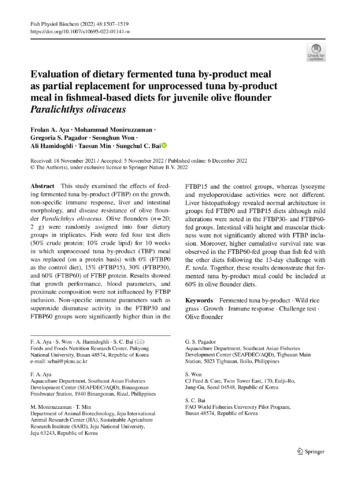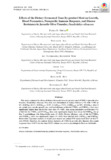Evaluation of dietary fermented tuna by-product meal as partial replacement for unprocessed tuna by-product meal in fishmeal-based diets for juvenile olive flounder Paralichthys olivaceus
- Global styles
- MLA
- Vancouver
- Elsevier - Harvard
- APA
- Help

View/
Date
2022-12-06Author
Page views
652ASFA keyword
AGROVOC keyword
Taxonomic term
Metadata
Show full item record
Share
Abstract
This study examined the effects of feeding fermented tuna by-product (FTBP) on the growth, non-specific immune response, liver and intestinal morphology, and disease resistance of olive flounder Paralichthys olivaceus. Olive flounders (n = 20; 2 g) were randomly assigned into four dietary groups in triplicates. Fish were fed four test diets (50% crude protein; 10% crude lipid) for 10 weeks in which unprocessed tuna by-product (TBP) meal was replaced (on a protein basis) with 0% (FTBP0 as the control diet), 15% (FTBP15), 30% (FTBP30), and 60% (FTBP60) of FTBP protein. Results showed that growth performance, blood parameters, and proximate composition were not influenced by FTBP inclusion. Non-specific immune parameters such as superoxide dismutase activity in the FTBP30 and FTBP60 groups were significantly higher than in the FTBP15 and the control groups, whereas lysozyme and myeloperoxidase activities were not different. Liver histopathology revealed normal architecture in groups fed FTBP0 and FTBP15 diets although mild alterations were noted in the FTBP30- and FTBP60-fed groups. Intestinal villi height and muscular thickness were not significantly altered with FTBP inclusion. Moreover, higher cumulative survival rate was observed in the FTBP60-fed group than fish fed with the other diets following the 13-day challenge with E. tarda. Together, these results demonstrate that fermented tuna by-product meal could be included at 60% in olive flounder diets.
Keywords
Fermented tuna by-product Wild rice grass Growth Immune response Challenge test Olive flounderSuggested Citation
Aya, F., Moniruzzaman, M., Pagador, G. E., Won, S., Hamidoghli, A., Min, T., & Bai, S. C. (2022). Evaluation of dietary fermented tuna by-product meal as partial replacement for unprocessed tuna by-product meal in fishmeal-based diets for juvenile olive flounder Paralichthys olivaceus. Fish Physiology and Biochemistry , 48(6), 1507-1519. https://doi.org/10.1007/s10695-022-01141-w
Type
ArticleISSN
0920-1742; 1573-5168Collections
- Journal Articles [1258]
Related items
Showing items related by title, author, creator and subject.
-
Effects of the dietary fermented tuna by-product meal on growth, blood parameters, nonspecific immune response, and disease resistance in juvenile olive flounder, Paralichthys olivaceus
Oncul, Fatma Ozgun; Aya, Frolan ; Hamidoghli, Ali; Won, Seonghun; Lee, Geon; Han, Kyoung R.; Bai, Sungchul C. (World Aquaculture Society, 2019)
This study evaluated the effects of dietary fermented tuna by‐product meal (FTBM) in juvenile olive flounder, Paralichthys olivaceus. Five diets were formulated to replace fishmeal (FM) with FTBM at 0% (FTBM0), ...
; Hamidoghli, Ali; Won, Seonghun; Lee, Geon; Han, Kyoung R.; Bai, Sungchul C. (World Aquaculture Society, 2019)
This study evaluated the effects of dietary fermented tuna by‐product meal (FTBM) in juvenile olive flounder, Paralichthys olivaceus. Five diets were formulated to replace fishmeal (FM) with FTBM at 0% (FTBM0), ... -
Hydrolyzed tuna meat by-product supplement for juvenile red sea bream, Pagrus major, and its effect on growth, enzyme activity, plasma parameters, and apparent nutrient digestibility
Mamauag, Roger Edward ; Ragaza, Janice Alano; Koshio, Shunsuke; Ishikawa, Manabu; Yokoyama, Saichiro (Society of Israeli Aquaculture and Marine Biotechnology (SIAMB), 2014)
A growth experiment was conducted on juvenile red sea bream, Pagrus major to investigate the effect of the inclusion in fish diets, of tuna meat by-product hydrolysate which was processed through enzymatic hydrolysis using ...
; Ragaza, Janice Alano; Koshio, Shunsuke; Ishikawa, Manabu; Yokoyama, Saichiro (Society of Israeli Aquaculture and Marine Biotechnology (SIAMB), 2014)
A growth experiment was conducted on juvenile red sea bream, Pagrus major to investigate the effect of the inclusion in fish diets, of tuna meat by-product hydrolysate which was processed through enzymatic hydrolysis using ... -
Mass larval rearing technology of marine finfish in Japan
Fukusho, Kunihiko (Aquaculture Department, Southeast Asian Fisheries Development Center, 1996)With economic development and increased demand for high price fish, industrial scale marine finfish culture in Japan was started in 1960-1965 for yellowtail Seriola quinqueradiata. Sustainable supply of wild juvenile and ...





